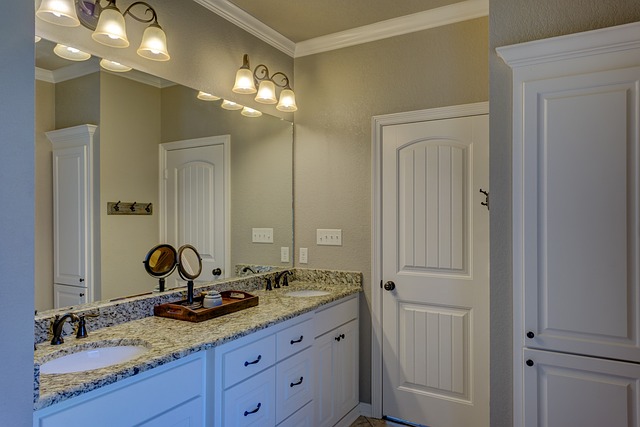Water and energy conservation in bathrooms is a growing priority for sustainable living. Dual-flush toilet systems are a key solution, reducing water usage by up to 20% compared to traditional models with just 6 liters per flush. These eco-friendly fixtures, combined with advanced showerheads, aerators, and smart technology, offer significant financial savings while minimizing environmental impact. By embracing these innovations, homeowners can contribute to sustainability and lower their water and energy bills.
In today’s eco-conscious world, reducing water and energy usage in bathrooms has become a priority. This article explores innovative bathroom appliances designed to conserve resources without compromising comfort or functionality. From dual-flush toilet systems that revolutionize waste management to low-flow fixtures and smart technology, these solutions offer significant benefits for both the environment and your utility bills. By understanding how these products work, you can make informed choices that contribute to a greener home.
- Understanding Water and Energy Conservation in Bathrooms
- The Role of Dual-Flush Toilet Systems in Water Conservation
- Other Efficient Bathroom Appliances: A Look at Low-Flow Fixtures and Smart Technology
- Benefits and Impact: Reducing Water and Energy Usage at Home
Understanding Water and Energy Conservation in Bathrooms
Water and energy conservation in bathrooms is becoming increasingly important as we look for ways to reduce our environmental impact. Bathrooms, often overlooked, can be a significant contributor to household water and energy usage due to various appliances such as toilets, showers, and sinks. In response, innovative solutions like dual-flush toilet systems have emerged as game-changers in sustainable living. These systems offer two flushing options—a lower-volume setting for liquid waste and a higher-volume option for solid waste—allowing users to minimize water consumption without compromising cleanliness.
Moreover, advanced showerheads and faucet aerators play a crucial role in energy efficiency. Water-saving showerheads reduce water flow while maintaining pressure, cutting down on both water and energy bills. Similarly, aerators fitted to faucets mix air with water, providing a satisfying user experience while using significantly less water than traditional fixtures. By adopting these smart appliances, homeowners can contribute to preserving precious resources and reducing their carbon footprint, making their bathrooms more eco-friendly and cost-effective.
The Role of Dual-Flush Toilet Systems in Water Conservation
Dual-flush toilet systems play a significant role in water conservation efforts, offering an effective solution to reduce water usage in bathrooms. These innovative systems provide two flush options: a shorter, lighter flush for liquid waste and a longer, more powerful flush for solid waste. This simple mechanism can lead to substantial water savings, as the average household uses approximately 20% of its water supply for toilet flushing alone. By choosing dual-flush models, homeowners can significantly cut down their water consumption without compromising on hygiene or performance.
The environmental benefits extend beyond water conservation. Dual-flush toilets also contribute to energy efficiency. The reduced water usage translates to less energy needed for water heating and treatment, leading to lower carbon emissions. This eco-friendly approach not only helps preserve natural resources but also provides long-term savings on utility bills. With their dual functionality, these toilet systems are a popular choice among those seeking sustainable bathroom upgrades.
Other Efficient Bathroom Appliances: A Look at Low-Flow Fixtures and Smart Technology
In addition to low-flow showerheads and water-efficient faucets, another game-changer in bathroom appliances are dual-flush toilet systems. These innovative fixtures offer a simple yet powerful way to reduce water consumption, with options for both liquid and solid waste disposal, typically using just 6 liters per flush – a significant saving compared to traditional toilets that can use up to 12 liters.
Smart technology is also making its way into bathrooms, providing even more opportunities for conservation. Smart showerheads, for example, can adjust water pressure and temperature based on user preferences, while smart thermostats and sensors in fixtures ensure energy-efficient heating and lighting. These advanced appliances not only help to conserve resources but also contribute to a more comfortable and modern bathroom experience.
Benefits and Impact: Reducing Water and Energy Usage at Home
Reducing water and energy usage at home is not just a sustainable practice but also offers significant financial savings for homeowners. By adopting efficient bathroom appliances, such as dual-flush toilet systems, families can substantially decrease their environmental footprint. These innovative systems provide two flushing options: a full flush for solid waste and a half-flush for liquid waste, enabling water conservation without compromising hygiene.
The impact of these changes is profound. Dual-flush toilets alone can save up to 70% of the water used in a typical household, translating to reduced water bills and less strain on local water resources. Moreover, by cutting down on water usage, these appliances also lower energy consumption tied to heating and pumping water, contributing to overall energy conservation. This dual benefit makes them an excellent investment for homeowners aiming to live more sustainably and reduce their carbon footprint.
In conclusion, embracing water and energy-efficient bathroom appliances, such as dual-flush toilet systems and low-flow fixtures, is not just an eco-friendly choice but also a smart financial decision. These innovations play a pivotal role in reducing household water and energy consumption, contributing to a more sustainable future. By integrating smart technology into our daily routines, we can significantly impact the environment without compromising on comfort or performance.
